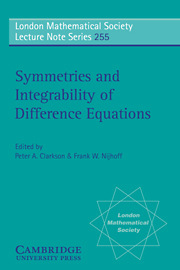Book contents
- Frontmatter
- Contents
- Preface
- List of Participants
- 1 Partial Difference Equations
- 2 Integrable Mappings
- 3 Discrete Geometry
- 4 Asymptotic Analysis
- 5 Discrete Painlevé Equations
- The discrete Painlevé I hierarchy
- Rational solutions to dPIV
- The discrete Painlevé II equation and the classical special functions
- Freud's equations for orthogonal polynomials as discrete Painlevé equations
- 6 Symmetries of Difference Equations
- 7 Numerical Methods and Miscellaneous
- 8 Cellular Automata
- 9 q-Special Functions and q-Difference Equations
- 10 Quantum Aspects and Yang-Baxter Equations
Rational solutions to dPIV
Published online by Cambridge University Press: 04 August 2010
- Frontmatter
- Contents
- Preface
- List of Participants
- 1 Partial Difference Equations
- 2 Integrable Mappings
- 3 Discrete Geometry
- 4 Asymptotic Analysis
- 5 Discrete Painlevé Equations
- The discrete Painlevé I hierarchy
- Rational solutions to dPIV
- The discrete Painlevé II equation and the classical special functions
- Freud's equations for orthogonal polynomials as discrete Painlevé equations
- 6 Symmetries of Difference Equations
- 7 Numerical Methods and Miscellaneous
- 8 Cellular Automata
- 9 q-Special Functions and q-Difference Equations
- 10 Quantum Aspects and Yang-Baxter Equations
Summary
Abstract
We study the rational solutions of the discrete version of Painleve's fourth equation (d-PIV). The solutions are generated by applying Schlesinger transformations on the seed solutions −2z and −1/z. After studying the structure of these solutions we are able to write them in a determinantal form that includes an interesting parameter shift that vanishes in the continuous limit.
Introduction
One important question in the study of discrete versions of continuous differential equations concerns the existence of corresponding special solutions. For continuous Painlevé equations rational and special function solutions are known, and in many cases even a rigorous classification has been done. If one proposes a discrete version of a Painlevé equation it is not enough that in some continuous limit the continuous Painlevé equation is obtained, but in addition the proposed equation should share some further properties of the original equation. One of these properties should be the equivalent of the Painlevé property, called “singularity confinement”. This has already been used to propose discrete forms of the Painlevé equations. Other structures of the continuous Painlevé equations that have been shown to exist for the discrete ones include their relationships by coalescence limits and the existence of Hirota forms for these equations. What is still largely an open question is the fate of the special solutions (rational, algebraic, special function) known for the continuous case.
- Type
- Chapter
- Information
- Symmetries and Integrability of Difference Equations , pp. 206 - 216Publisher: Cambridge University PressPrint publication year: 1999
- 3
- Cited by

